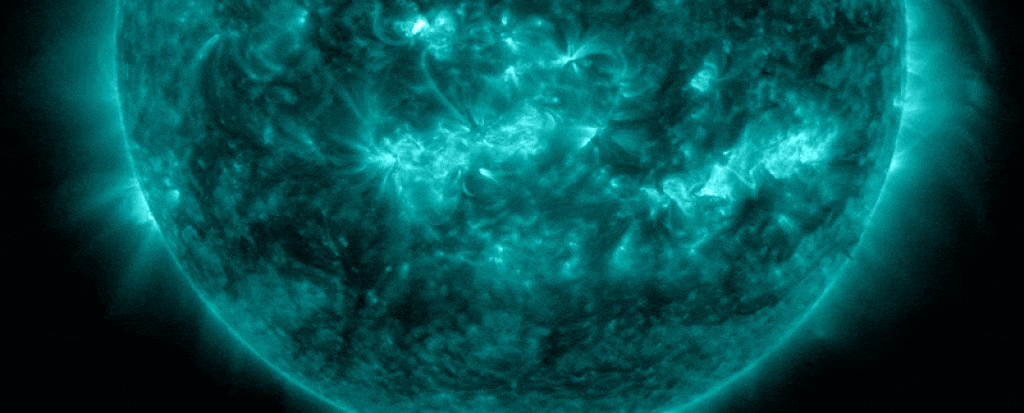Rampant solar shenanigans are about to slam Earth and make some real purty lights in the sky.
In recent days our Sun has erupted repeatedly, unleashing several coronal mass ejections (CMEs) and solar flares in Earth’s direction. It’s unclear when exactly the blasts of CME material will arrive at Earth, but the next few nights are forecast to come alive with dancing auroras.
The reason? There’s a cluster of sunspot regions speckling the solar equator, currently rotating right past Earth as it belches out fire and fury.
At time of writing, the past 24 hours had seen six M-class flares and one X-class flare erupt from the Sun. These are bright flashes of light that appear on the surface of the Sun, which coincide with emissions of X-rays and ultraviolet radiation that can cause brief communications blackouts here on Earth.
X-class flares are the most powerful flares the Sun can produce; M-class flares are the category just below X-class.
In addition to the solar flares, the Sun has been spewing out huge eruptions of solar plasma tangled with magnetic fields that propagate through the Solar System. These are CMEs, and they sometimes occur with solar flares. Both are strongly associated with sunspot regions, where the solar magnetic field becomes tangled, snaps, and reconnects, unleashing huge bursts of energy.
Here on Earth, such activity is unlikely to interfere much with day-to-day life, but CMEs can cause geomagnetic storms when they slam into Earth’s magnetosphere. The exchange of energy can cause major disturbances in Earth’s magnetic field, upper atmosphere, and plasma environment.
And, of course, there are the auroras. Particles from the CME and solar wind smack into Earth’s magnetic field, and get diverted and accelerated along the magnetic field lines to the poles, where they are dumped into Earth’s upper atmosphere. There, interactions with particles within the ionosphere creates beautiful glowing lights, with different colors depending on the particles involved.
Earlier this year, we saw the most powerful geomagnetic storms in decades, categorized at the G5 “extreme” level. The incoming storms are not expected to be quite that powerful, but they are still forecast to be pretty amazing with some reaching G3, classified as “strong”, thanks to a phenomenon called a cannibal CME that produces an enhanced delivery of solar material.
Our latest modeling – as shown in this animation – indicates Earth’s outer atmosphere may begin to feel impacts from the recent coronal mass ejections around 06-12 UTC July 30. A G3 Watch Remains in effect for Tuesday with G2 conditions possible through August 1. #SpaceWeather pic.twitter.com/S5z9iJlqGr
— NOAA Space Weather Prediction Center (@NWSSWPC) July 30, 2024
A cannibal CME occurs when two CMEs occur in relatively quick succession. If the second CME is traveling faster than the first, it will catch up and ‘swallow’ the slower one, becoming, in effect, one huge rolling wave of solar material heading through the Solar System.
The brunt of this impact is expected to be felt on 30 July, with aurora seen in the Northern Hemisphere as low as Pennsylvania to Iowa to Oregon, as well as Scotland, and the southernmost parts of mainland Australia in the Southern Hemisphere, as well as most of the South Island of New Zealand.
frameborder=”0″ allow=”accelerometer; autoplay; clipboard-write; encrypted-media; gyroscope; picture-in-picture; web-share” referrerpolicy=”strict-origin-when-cross-origin” allowfullscreen>
Even more excitingly, these currently incoming CMEs are from a glancing blow. At the time they were released, the sunspots were not quite aligned in the direction of Earth.
The rotation of the Sun has brought the spots into the middle of the solar disk, where they are positioned for maximum impact should the solar rampage continue.
With the Sun’s activity peak in full swing, there’s no reason to believe that it won’t. So get out there, and enjoy the show.





